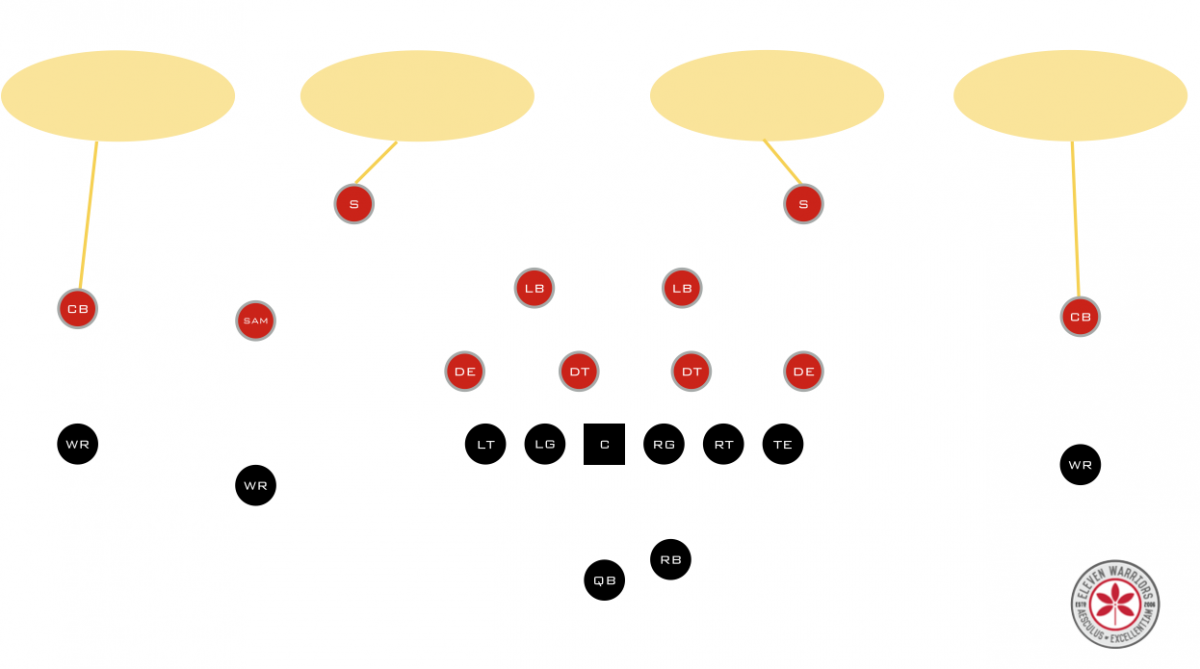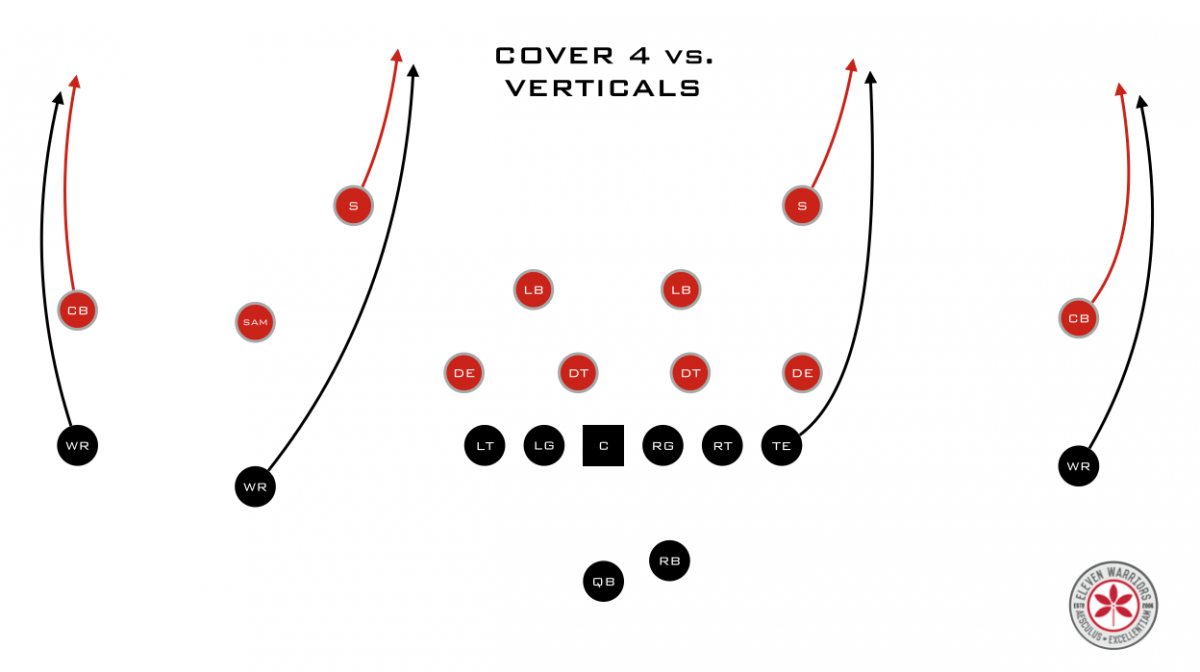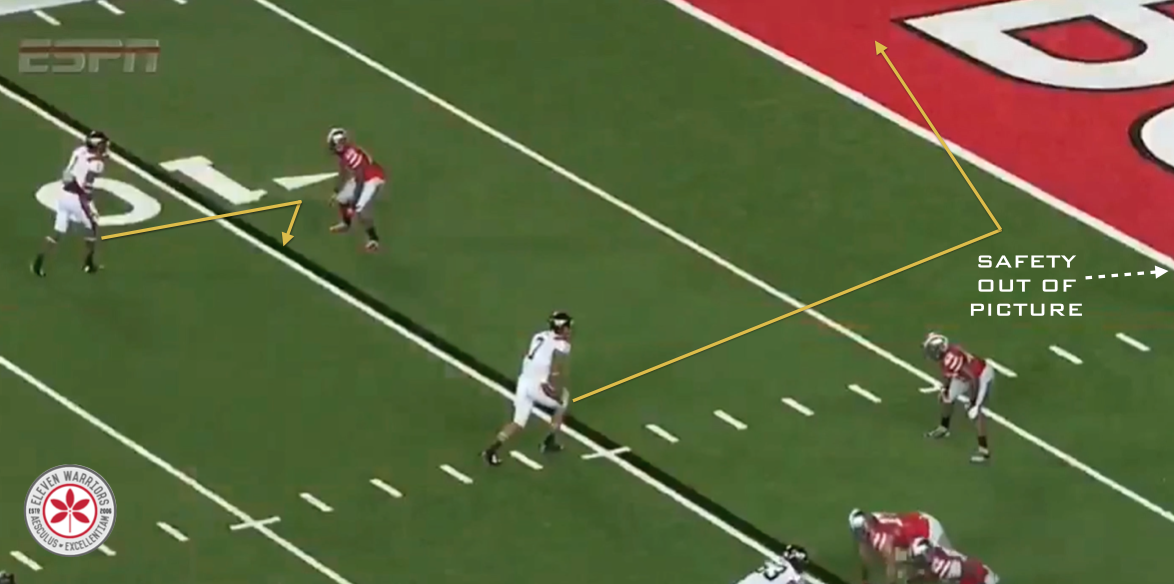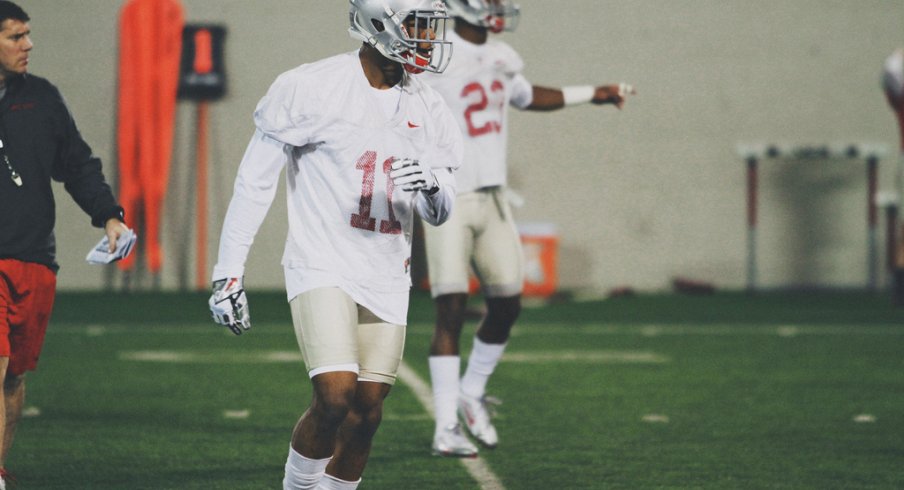Chris Ash was given a monumental task last winter.
As the Buckeyes looked to move past back-to-back losses to end the 2013 campaign, the weakest spot on a team that had won 24 straight games was clear: a pass defense that ranked 112th in the country by year's end.
After secondary coach Everett Withers moved on to take the head coaching job at James Madison, Urban Meyer brought in Ash to install the latest defensive coaching trend in college football, the Cover 4 defense.
Led by programs like Michigan State and Alabama, the Cover 4 is considered to be the best schematic approach to stopping spread formations and plays that look to stretch defenses both horizontally and vertically, now the norm for collegiate offenses.
For those of us that grew up playing the Madden or NCAA Football video games, your interpretation of a "Cover 4" zone probably looks something like this:

The defense creates the illusion of a wide, sweeping net that catches all receivers at a certain point downfield, leaving the three linebackers underneath to cover all the ground in front of that back line. As such, many of you probably never called this play except on 3rd and a mile, probably assuming your opponent was throwing a Hail Mary.
In reality though, the Cover 4 that is run by the Buckeyes, Spartans, and most teams at that level bears little resemblance to that play.
The scheme these teams employ allows the secondary to respond to any kind of route from the offense by jumping right into a man or zone coverage.
For instance, against vertical routes, the defensive backs will cover the receivers in man-to-man coverage with the cornerbacks taking the outside receivers and the safeties looking to the inside receiver to their side, either the slot receiver or tight end.

If the offense runs crossing routes underneath, the defenders will stay in the zone in which they lined up, handing off coverage to the next man before looking for a new man to cover.
In addition to pass coverage, this alignment allows the safeties to keep an eye on the backfield if the inside receiver stays in to block, giving them the chance to come up in run support without worrying about the chance of a receiver going deep, as the cornerback next to them is there in coverage.
This tactic allowed the Michigan State defense to stifle the inside running game of Ohio State in Big Ten championship last December, knowing any threat of a deep pass to a Buckeye receiver would be handled by their NFL-caliber corners.
The Cover 4 has countless rules, adjustments, and nuances that can be built in once the basics have been mastered, which is what separates not only the good coaches from the average, but also the way the game is played at the pro level vs college. With the NCAA placing restrictions on the time teams can spend on the field each day, the ability to teach and implement new wrinkles quickly is paramount.
Thus far, implementing this scheme has lived up to the billing for the 2014 Buckeyes, who currently rank 4th in the nation in pass defense. But the numbers are a bit skewed, as the OSU secondary only saw four passing attempts from the Navy Midshipmen in week one, and faced a Kent State team that was overmatched in every facet of the game in last Saturday's 66-0 win.
The best test for Ash's secondary has been the matchup with Virginia Tech, which saw the Buckeyes surrender 199 yards through the air. Though still respectable, that sum would rank a pedestrian 36th nationally in passing yards given up per game, a position below what many Buckeyes fans desire (and frankly, expect).
But what often gets lost in the excitement of watching a game is the fact that 11 players are responsible for covering an area 53.5 yards wide and potentially 110 yards long (with the end zone). Add in the very simple fact that unless they're called to blitz through a specific spot, they rarely know where they're going to go on a given play until the offense tells them. They may know a general area or direction, but the exact spot is almost always unknown.
In contrast, not only does every player on the offense know where they're going, they know that defenses will only defend them in a handful of ways, and have counter-moves built in to adjust on the fly.
A defense like the Cover 4 is currently the best solution to cover as many scenarios as possible, but it's impossible to cover all of them at once.
One example comes from the Virginia Tech game, in a situation that drove many OSU fans crazy, Bucky Hodges' touchdown catch that would prove to be the game-winner.

As the Buckeyes continued to show the Cover 4 defense throughout the evening, the Hokies called for the "Smash" concept, featuring the outside receiver running a short hitch or curl with a corner route from the inside man. This concept is one of the best-known ways to beat the Cover 4, as the cornerback must step up and cover the outside receiver who doesn't leave his zone, leaving a wide open area behind him.
OSU Safety Vonn Bell recognizes the route quickly, but since he is coming from the middle of the field, Brewer is able to throw the ball in front of Hodges just enough to beat Bell's outstretched arms.
The Buckeye defender properly identified his assignment, yet still gave up a touchdown, as Bell's break on the ball was parallel to Hodges, as opposed to cutting off the angle from the quarterback to receiver.
The OSU secondary has struggled thus far is in denying the ball in these man-coverage situations. As Alabama head coach, and longtime defensive guru, Nick Saban said at a coaching clinic,
"There are times in a game when you must deny the ball. It is like basketball. If you want to get the ball back at the end of a game, you cannot play a "2-3" zone defense.
...
We have a "deny the ball distance" which is third down and seven yards or less for the first down. After the third down you can play zone and break on the ball, tackle the receiver, and do things like that. There is a time where you must play close coverage."
This does not mean that the OSU pass coverage is in trouble though, as the techniques of playing man coverage are brand new to this group. In that same speech, Saban would go on to talk about just a few of the countless adjustments, drills, and techniques used by his defenders to deny the ball in man coverage.
In time, the Buckeye secondary players will be exposed to, and will likely master these techniques as long as the Cover 4 scheme is still in place, therein showing the key to the success of the scheme. Like any system, concept, or strategy in football, the longer a team learns and practices a particular scheme, the better they'll be at executing it.
Pat Narduzzi is in his seventh year as the defensive coordinator at Michigan State, and though he is now looked at as a coaching genius, his teams struggled early in his tenure in East Lansing. The 2009 Spartan defense was ranked 112th in nation in pass defense, but by 2011, when the secondary was full of players who had spent their entire careers in his system, the unit ranked 11th. In the years since, Narduzzi has never seen a defense rank outside the top 10 in that category.
The current Buckeye squad is learning on the fly with Ash, and appears to be doing a good job picking up the basics thus far. By allowing the defensive backs to master one coverage over the course of the season and learning how to adjust it to specific opponents, routes, and situations, they can advance from the 101 stage to master classes as the season progresses.
The 2013 Buckeyes never got past the introductory level for any of the coverages they played. Often going in and out of different schemes and packages from week to week, the secondary never had the chance to learn the specific nuances of each, and the results spoke for themselves.
The biggest indicator of success for the OSU secondary thus far has been the lack of big plays surrendered. The longest play given up through three games has been only 18 yards, a testament to the fact that these secondary players at least know where they're supposed to be, even if the technique isn't there yet to deny the ball.
In that same speech to a group of coaches, Saban noted the following,
Receivers wlll catch the ball. It's how hard you make it for them to do it. You must minimize the percentages of the throws. The big stat in pass defense is how many yards the offense gets (per) attempt throwing the ball. If you give too many big plays, your yards per attempt is not going to be good.
Through three weeks of the 2014 season, the Ohio State defense is giving up an average of 4 yards-per-attempt, nearly half the 7 yard average-per-attempt given up by the 2013 Buckeyes. All in all, a dramatic improvement.
So the next time the Buckeyes give up a short gain through the air, instead of calling for Ash to be fired or for a backup to come into the game, take a step back and look at the bigger picture. This defense is on the right path towards becoming very good in pass coverage. They just haven't arrived at their destination quite yet.


